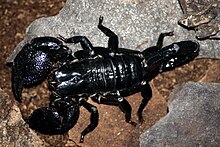Pandinus
| Pandinus | |
|---|---|
 |
|
| Pandinus imperator | |
| Scientific classification | |
| Kingdom: | Animalia |
| Phylum: | Arthropoda |
| Class: | Chelicerata |
| Order: | Scorpiones |
| Family: | Scorpionidae |
| Subfamily: | Scorpioninae |
| Genus: |
Pandinus Thorell, 1876 |
| Type species | |
|
Buthus imperator C. L. Koch, 1841 |
|
| Diversity | |
| 5 subgenera, about 21 species | |
Pandinus is a genus of large scorpions belonging to the family Scorpionidae. It contains one of the most popular pet scorpions, the emperor scorpion (P. imperator). The genus is distributed widely across tropical Africa and the southwestern Arabian Peninsula (Yemen, Saudi-Arabia).
The genus was introduced in 1876 by Tamerlan Thorell. Subsequent research subdivided the genus into five subgenera, however recent studies doubt on these subgenera to represent natural groups.
Currently 21 species are recognized within this genus:
Pandinus boschisi Caporiacco, 1937, known only from one, presumably lost specimen from Somalia, is considered a nomen dubium.
Members of Pandinus are generally large sized scorpions (c. 120–200 mm total length), which are dark to black colored, sometimes with paler metasoma and legs. The pedipalp pincers are massive while the metasoma is proportionally thin with a small vesicle and stinger (aculeus). They possess a stridulatory organ, composed of a rough area on the first segment (coxa) of the pedipalps and a 'scraper' made of bristles on the first segment of their first pair of walking legs. Scraping these bristles on the rough zone produces a scratching sound. Genera of the subfamily Scorpioninae are extremely similar to each other and Pandinus is especially close to the south-east Asian genus Heterometrus. They differ mainly in details of the stridulatory organ and sensory bristles (trichobothria).
As in other Scorpionidae, the venom of Pandinus species is rather mild, human fatalities are unknown. Symptoms are mostly restricted to local pain, described similar to those of a bee sting. At least P. imperator rarely stings at all, and often prefers to use its massive pincers for prey capture and even for defense. The defensive behavior of the other species is not yet studied in detail.
...
Wikipedia
